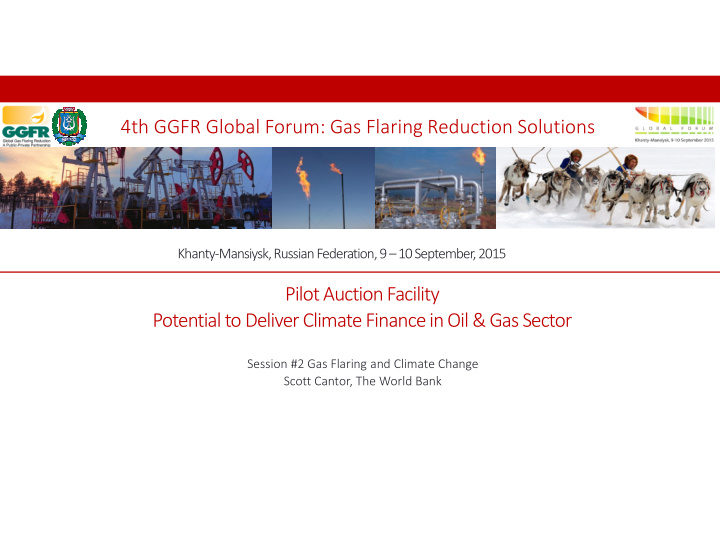



4th GGFR Global Forum: Gas Flaring Reduction Solutions Khanty-Mansiysk, Russian Federation, 9 –10 September, 2015 Pilot Auction Facility Potential to Deliver Climate Finance in Oil & Gas Sector Session #2 Gas Flaring and Climate Change Scott Cantor, The World Bank
The PAF’s Objectives and Scope • Pilots an innovative climate finance mechanism that uses auctions to maximize impact of funds • Provides incentive for private sector investment in projects that reduce greenhouse gas emissions • Disburses resources against independently verified emission reductions • $100m target capitalization – learning a key objective for scaling-up or replication for use with other pollutants or other results 2 PAF Contributors
The PAF Offers a Price Guarantee by Using the Financial Equivalent of a Put Option • Carbon credit prices collapsed, stranding projects with no incentive to reduce emissions • The PAF uses “put options” to guarantee a floor price for sale of future carbon credits • Put options give the right, but not the obligation to sell at the guarantee price Historic and hypothetical emission reduction prices* • The auction result sets the guarantee Paris price level COP ? • Auctioning ensures that the least-cost climate mitigation activities are “Put option” price guarantee selected • Auction winners purchase the price 2008 2010 2012 2014 2016 2018 2020 guarantee (pay put premium) Price guarantee exercised Price guarantee not exercised 3 *Prices after 2014 are hypothetical and for explanatory purposes only.
For Background – The PAF’s First Auction Result 4
Why Consider a Climate Finance Mechanism in the Oil and Gas sector? • The sectors own emissions 8% of global GHG emissions • Targeted by the IEA as a priority area of early and cost-efficient mitigation options (Bridge Scenario) • Barriers hinder emission reduction efforts Flaring of associated gas • A massive resource waste • Large potential for low cost GHG mitigation • Significant co-benefits from reduced smog and particle emissions • Momentum building up to address flaring, e.g. Zero Routine Flaring by 2030 initiative • Climate finance (e.g. PAF-like instrument) can contribute and help reinforce national policies 5 Sources: Carbon Limits analysis based on the data from NOAA/GGFR, IEA, Rhodium 2015 .
Analyzing Suitability of a PAF-like Instrument to Support Reduction in Gas Flaring Investment sub-categories and aspects against which their suitability is evaluated Calculation of GHG impacts GF1 Power for own site use Relevant MRV framework being sound and practical New standards not entailing large costs Power for own site use and Predictability and low risks in GHG calculations GF2 delivery to market GF3 Gas delivered by pipeline Economic impacts Scale of emission reductions Price paid per tCO 2 e reduction up to 10 US$ Gas delivery by mobile equipment GF4 (CNG/LNG) “Free riders” and perverse incentives On site liquefaction of gas GF5 (GTL/GTF) Target investments that facing barriers Avoid relaxation of flare policies and regulations GF6 Reinjection of gas Large scale gas processing and Auctioning and tradability GF7 delivery by pipeline Eligible players: fields that flare and face barriers Cost structures, emission reduction profiles and investment lead time which impact Large scale LNG/GTL/GTC deign of instrument GF8 investment 6 Pictures: GE, Fleet and fuels, Gazprom, EME, SINTEF,
Way Forward to Explore Opportunities to use PAF-like Mechanism for Reduction of Gas Flaring Conclusions • Small and medium scale projects score best on applicability test • Four sub-categories offer the best opportunities: • Power for own use • Power for own use and delivery to market • Gas delivery by pipeline • Gas delivery by mobile equipment (CNG/LNG) Next step: • Receive comments and engage in discussion with stakeholders • Explore possible facility design Issues for discussion: • Can results based climate finance, like the PAF, play a role? • Is a guaranteed price for carbon credits important to unlock barriers? • In instrument design: how to balance simplicity with environmental integrity? • Is auctioning and tradability preferable to administrative pricing? 7
ANNEX 8
Gas flaring sub-categories suitability assessment Calculation of Economic impacts “Free riders” Auctioning and GHG impacts tradability Perv. incentives GF1 Power for own use GF2 Power for own use and to markets GF3 Gas delivered by pipeline GF4 Delivery by mobile equipment (CNG/LNG) GF5 Small and medium size gas to liquids (GTL) GF6 Reinjection of gas GF7 Large gas processing & delivery by pipeline GF8 Large scale LNG/GTL/GTC High Score on evaluation aspects: Medium Low Not suitable 9
Recommend
More recommend